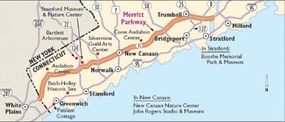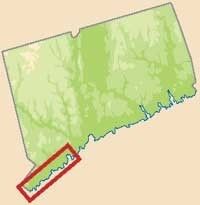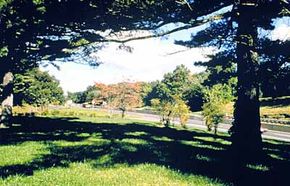Built with pride in the 1930s as a "Parkway," Merritt Parkway in Connecticut is more sinuous than modern highways, winding its way through parklike landscaping and under Art Deco bridges. Truck-free, it's an alternative to I-95 through Connecticut to New York City.
Merritt Parkway is one of the only roads listed on the National Register of Historic Places, a distinction usually reserved for buildings or battlefields. Drive Merritt Parkway, and see for yourself why it inspires both reverence and devotion among fans and supporters, many of whom use it daily or live near its winding path through Connecticut's Fairfield County. Built in the 1930s to cope with America's new fascination with the automobile, this byway is enshrined in the hearts of many as an icon of the automobile age and a model of highway planning.
Advertisement
Cultural Qualities of Merritt Parkway
As a scenic byway, Merritt Parkway has won national acclaim. From political leaders to talk show hosts, everyone has something to say about this parkway, and it always has something to do with the beautiful scenery visitors will experience on the prettiest drive in Connecticut.
The road is half a century old and is traveled daily by at least 60,000 vehicles, but it remains a perfect combination of nature and industry. Perhaps it is because of the amount of travel that occurs on the road that it has become part of our nation's cultural heritage. Whatever the case, people inside and outside of Connecticut know about the Merritt Parkway.
Qualities of Merritt Parkway
On July 1, 1934, Oscar Tuthill, the First Selectman of Greenwich, turned a spade of earth at King Street near the Connecticut–New York border to begin construction of the Merritt Parkway, which was among the first parkways in the nation and the first median-divided, limited-access highway in Connecticut. Its name was changed from Merritt Highway to Merritt Parkway one year after construction began. On September 2, 1940, just more than six years later, the final section of the roadway was completed and the entire parkway opened to traffic.

Described by one historian as "one of the most beautiful and best-engineered highways of the time," the parkway was built to solve traffic problems in the state. Before the parkway, local motorists and long-distance travelers were forced to compete for the same highway space. Drivers could move only at slow speeds, and merchants in communities along the route were upset because their customers were unable to find convenient parking.
The Merritt Parkway was a direct product of a period in American road-building history when there was a great deal of interest in linking urbanized regions with graceful highways set in natural surroundings. This parkway quickly emerged as a national model. To ensure a natural appearance, long, gradual, vertical curves were designed. Rock cuts were rounded and landscaped to produce a natural setting. The Merritt Parkway's designers attempted to integrate the traveled way into the roadside and its surroundings. The landscaping of the parkway followed closely upon completion, attempting to heal the scars of construction.
In addition to the roadside beauty that can be viewed while driving along the Merritt Parkway, motorists are also treated to a unique exhibition of ornamental bridges. These structures were the creation of George Dunkelberger, an innovative bridge designer and architect. There were originally 69 bridges, with some carrying the parkway under intersecting roads and railroad tracks and others carrying the parkway over intersecting roads and rivers.
These bridges were designed primarily in the Art Moderne and Art Deco styles, with no two alike. In the more than 50 years since the parkway's completion, three of the original bridges have been replaced and a number of others have been altered in response to needed maintenance or repair, but the bridges still remain a scenic element of the byway.
The 37-mile roadway now stretches across Fairfield County from the town of Greenwich to the Housatonic River in the town of Stratford. The stately, neatly landscaped parkway connects the Hutchinson River Parkway at the New York state line with the Wilbur Cross Parkway at Stratford. Together, the Merritt and Wilbur Cross Parkways form part of Route 15 in Connecticut.
In 1991, the parkway was listed on the National Register of Historic Places, a statement of its role as a nationally recognized cultural resource as well as a valued part of Connecticut's heritage. It is also a critical transportation facility for the southwestern part of the state. In early 1992, the parkway was designated as a State Scenic Road, further highlighting its importance to Connecticut's character. Six decades since its creation, millions of motorists from all over the nation still enjoy the scenic beauty of the parkway, especially its brilliant spring displays and rich autumn foliage.
Qualities of Merritt Parkway
The bridges of the Merritt Parkway make it unique, but the landscaping plays another important role for the parkway. The green trees and lawns that surround the parkway in the warmer months of the year are missed in the winter. Each fall, the landscaping reveals its more colorful side, and the Merritt Parkway becomes one of the most popular byways in the country. The landscaping on the parkway avoids being urbanesque by appearing to be the rolling hills of a New England wood.
Over the years, the placement of trees along the parkway has been carefully considered and maintained. When Merritt Parkway was first constructed, landscape architect Weld Thayer Chase selected the exact location for each major new tree. It was the vision of landscape artist Earl Wood to rely on native plant species rather than introduce exotic ones.
The landscapers talked the parkway engineers into saving many existing trees along the route and transplanting plants scheduled for removal in temporary nurseries to be reused after construction. The rolling hills along the parkway were also carefully landscaped. The jagged outcrops of stone exposed by blasting were covered with pockets of plant materials, and it helped to retain the natural feel of the parkway.
Dealing with Dunkelberger's bridges presented a special challenge, since some planting was needed to help them blend in. Chase solved the problem of revealing the abutments of the bridges by planting low, spreading shrubs as ground cover near the bridges and larger trees in clusters angling back from the abutments. The parkway plants continue to grow and flourish today. Current landscape architects still carefully place new trees along the byway to preserve its natural look. So take a leisurely drive along the Merritt Parkway and enjoy nature as you travel from one city to another.
Qualities of Merritt Parkway
The Merritt Parkway was designed and built as a driver's road. Efficiency and speed took a back seat to the enjoyment of those who would sit in the front seat, especially the driver. Understandably, the primary form of recreation that is available is simply driving the Merritt Parkway.
With an engaging variety of twists and turns, intriguing highway architecture, and lush, native surroundings, the Merritt Parkway has become a popular route for tourists and commuters alike. Due to its popularity, morning and afternoon rush hours are not the most pleasant times to travel the route and should be avoided if possible. At other times, a drive down the Merritt Parkway is a memorable driving experience that anyone can appreciate.
Find more useful information related to Connecticut's Merritt Parkway:
- Connecticut Scenic Drives: Merritt Parkway is just one of the scenic byways in Connecticut. Check out the others.
- New Canaan, Trumball: Find out what there is to do in these cities along Merritt Parkway.
- How to Drive Economically: Fuel economy is a major concern when you're on a driving trip. Learn how to get better gas mileage.
Advertisement

